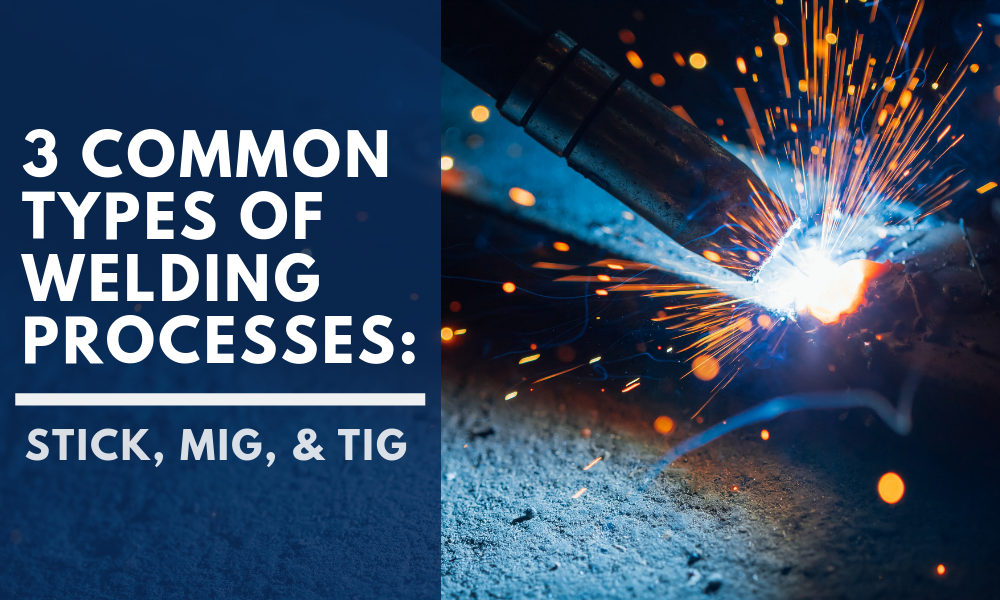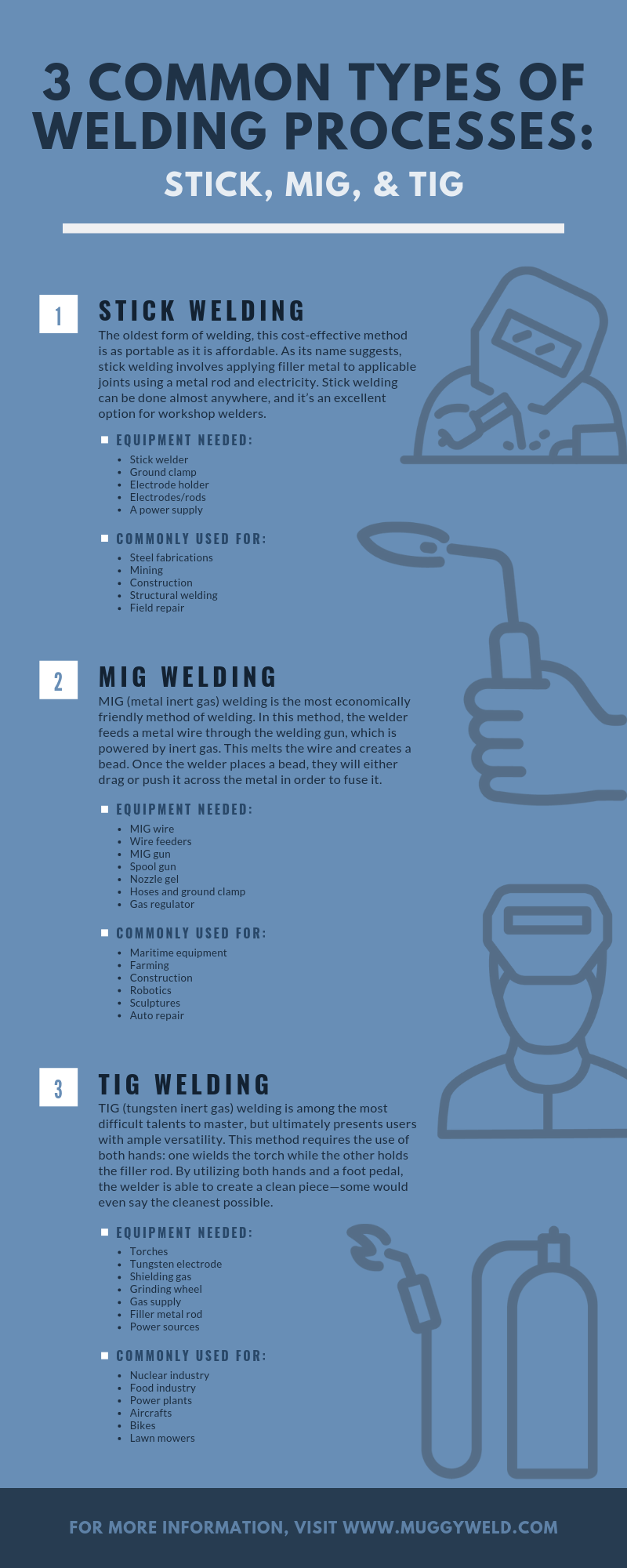MIG, TIG, and stick welding are commonly used in modern manufacturing. However, welding is a high-skill process with a history that traces all the way back to the Bronze Age. The operation involves fusing pieces of metal together with heat and, often, force. Anyone whose knowledge does not extend beyond hammer-wielding blacksmiths may not know that there are several different ways to work with metal. Some of these methods are more efficient than others, but the method used is entirely dependent on the desired outcome and the individual project.
Skilled welders must know all the components of metalworking in order to properly practice their art. The ability to differentiate between various methods and tools is what sets a true professional apart from a less seasoned worker. Connoisseurs should be able to select the methods and tools that present the opportunity for the best possible results.
Whether you’re an amateur seeking out further information or a seasoned professional looking for a refresher, your success is our goal. We provide premium welding supplies that will aide your endeavors for the perfect weld. However, what we have to offer is only a part of the equation—you’re the talent that makes our tools work to their maximum potential. For this reason, we’ve created a brief overview of the different welding processes for welders of any skill level: MIG, TIG and stick welding.
Stick Welding
The oldest form of welding, this cost-effective method is as portable as it is affordable. As its name suggests, stick welding involves applying filler metal to applicable joints using a metal rod and electricity. Stick welding can be done almost anywhere, and it’s an excellent option for workshop welders. It can also be used on most metals.
Despite its convenience and portability, the technique still has its flaws. It doesn’t always give the precise results that you can expect from other methods. Since it’s one of the most archaic forms of welding, it hasn’t been refined in the way others have been. The end product may not be as durable as it could be, although a skilled welder can still present beautiful results.
Equipment Needed:
- Stick welder
- Ground clamp
- Electrode holder
- Electrodes/rods
- A power supply
Commonly Used For:
- Steel fabrications
- Mining
- Construction
- Structural welding
- Field repair
MIG Welding
MIG (metal inert gas) welding, also known as GMAW (gas metal arc welding), is the most economically friendly method of welding. It’s also said to be the easiest to learn. In this method, the welder feeds a metal wire through the welding gun, which is powered by inert gas. This melts the wire and creates a bead. Once the welder places a bead, they will either drag or push it across the metal in order to fuse it.
MIG welding requires less precision than other methods. However, with higher quality comes higher prices, and the materials used for this method are not inexpensive. The project must also be performed indoors, as the tools are susceptible to harm from the outside elements.
Equipment Needed:
- MIG wire
- Wire feeders
- MIG gun
- Spool gun
- Nozzle gel
- Hoses and ground clamp
- Gas regulator
Commonly Used For:
- Maritime equipment
- Farming
- Construction
- Robotics
- Sculptures
- Auto Repair
TIG Welding
TIG (tungsten inert gas) welding, or GTAW (gas tungsten arc welding), is among the most difficult talents to master, and it isn’t usually recommended for beginners. However, the learning curve ultimately presents users with ample versatility. This method requires the use of both hands: one wields the torch while the other holds the filler rod. During the welding process, heat courses through the electrode and creates an arc. The torch hovers just above the metal, and the welder must be sure to not let the two elements meet. By utilizing both hands and a foot pedal, the welder is able to create a clean piece—some would even say the cleanest possible.
The two-handed method grants welders a substantial amount of precision, allowing them to take complete control over their projects. TIG welding should only be used on clean metal, as other options will cause a decrease in quality. It’s also a longer process, demanding extra time and preparations that other methods may not require. Though tedious, it generally provides optimal results.
Equipment Needed:
- Torches
- Tungsten electrode
- Shielding gas
- Grinding wheel
- Gas supply
- Filler metal rod
- Power sources
Commonly Used For:
- Nuclear industry
- Food industry
- Power plants
- Aircrafts
- Bikes
- Lawn mowers
How Rods Are Selected
Earlier, we mentioned selecting the correct MIG, TIG, or stick welding rod for your project. Seasoned welders know that this plays an important role in the final outcome of the project. Your welding position, as well as your base metal, should factor into this decision. You’ll also want to match your rod to your base. Another important thing to consider is the rod’s tensile strength. This determines how much additional strength can be added to the base metal. There will be four digits on your rod; the first three represent its tensile strength—the higher the number, the stronger the rod. The fourth digit represents the type of coating.
An all-position rod will allow you to work with the material regardless of whether you choose to sit or stand. This is an ideal option for beginners who have yet to settle on one position.
Safety
One of the most important things to consider when welding is your safety. Something as simple as an open-collared shirt can invite ugly burns, so wearing the proper clothing should be your priority. You should make sure that none of your skin is exposed while you’re working. Outfit yourself in the correct protective gear, including carefully selected headgear.
You’ll also want to be sure that you’re able to comfortably breathe. Exposure to fumes can cause health hazards, so be wary when working in confined spaces. Make sure the ground around you is clear so that you don’t risk falling over anything when working.
Lastly, thoroughly read all instruction manuals that accompany your equipment. If you can’t find the manuals, search for online resources. Seasoned welders may be familiar with safety procedures, but these instructional booklets should never be thrown away.
When you find the perfect combination of technique, materials, and safety, you’ll be in the best position possible to create high-quality work that will stand out among other projects. Prepare your materials and start welding—you’ve got a long and prosperous career ahead of you.


